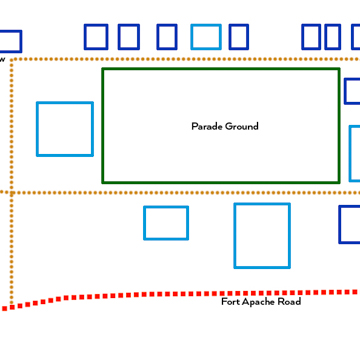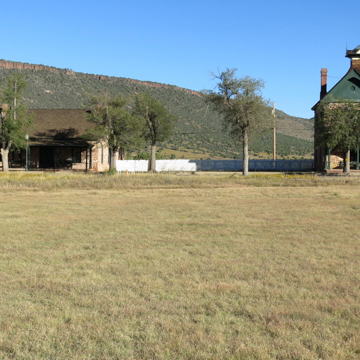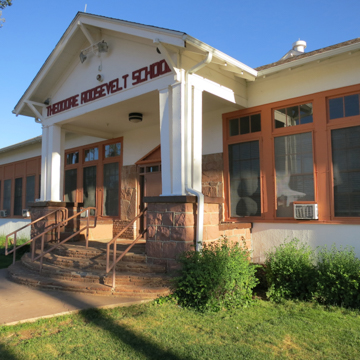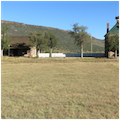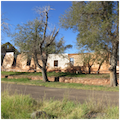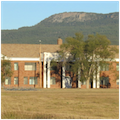Fort Apache, established in 1870 as Camp Ord, is located on the flanks of Arizona’s White Mountains, on a bluff above the confluence of the East Fork and North Fork of the White River. The White Mountain Apache Reservation, which surrounds the fort, was established in 1871.
The White Mountain Apache have occupied this territory at the headwaters of the Salt and Gila rivers since at least the 1600s. By the 1800s they had well-established farming areas along the East and North Forks of the White River and the region’s other perennial streams. Although tethered to farmsteads during planting and harvesting seasons, Apaches also traveled extensively to gather plant foods, hunt, and raid. Following the Civil War, as settler incursions into Apache territories escalated, the U.S. sought to limit conflicts by clarifying the boundaries of Indian and public lands, a process that was an important part of President Ulysses Grant’s so-called peace policy.
The site of Fort Apache was obtained through negotiation with White Mountain Apache regional tribal leaders in an effort to establish peaceful relations between Apaches and white settlers. To this end, the post (renamed Fort Apache in 1879) was a crucial link in the chain of forts supporting the United States military effort to control the American Southwest. Its strategic importance increased because inconsistencies in the application of Grant’s peace policy coupled with violent provocations by both Apaches and newcomers to spark a continuation of the Apache Wars until the final surrender of Geronimo and the last Chiricahua resistors in 1886. During this period and into the 1900s, Fort Apache served as a recruitment center for the Apache Scouts, young tribal men enlisted by the U.S. Army to serve as translators and de facto military police. It was also a base for the Buffalo Soldiers, all African American regiments that served on the western frontier; companies of the 24th and 25th Infantry and troops of the 9th and 10th Cavalry all served here.
In the decades following the confinement of Indian tribes to reservations, federal Indian policy shifted from subjugation to assimilation, and in the 1920s the fort was transformed into the Theodore Roosevelt School, a boarding and day school run by the Bureau of Indian affairs (BIA). Today, the 300-acre Fort Apache and Theodore Roosevelt School National Historic Landmark is composed of a quadrangular parade ground surrounded by 27 historic buildings and associated structures reflecting its operations as military fort and Indian boarding school.
In individual structures and overall layout, the site retains definitive characteristics of a military camp transformed into a campus. Both the Army post and the Indian school were oriented to the rectangular parade ground. Framed by tree-lined roads to north and south and by essential buildings to the east and west, the open space hosted the military and school drills and assemblies that defined and made operational the hierarchies at the core of Army and BIA organizational structures and practices. An associated cemetery, first established by the Army and still in use, is located approximately a quarter mile east of the main campus.
Though in its earliest military iteration, the site was set up as tent camp. Log cabins replaced the tents in 1871–1872; of these, only the original commanding officer’s quarters remains on the northwest corner of the quadrangle. The adobe adjutant’s office, built in 1876, is located at the northeast corner of the parade ground, where it now serves as a U.S. post office. Beginning in the late 1870s the Army milled lumber from local timber, and a row of frame houses were constructed along the northern side of the parade ground. In 1892 a Victorian mansion was built for the commanding officer, later to be occupied by the Theodore Roosevelt School principal. Situated at the midpoint of officers’ row and directly north of the flagstaff on the parade ground, the mansion’s location emphasizes imposed order and hierarchical authority. Higher-ranking staff members were quartered closer to this central point; lower status personnel were housed further down the street. In the 1880s frame housing was constructed for non-commissioned officers. Frame and adobe barracks for the enlisted men were sited along the south edge of the parade ground, definitively separated from officers’ row. The last of these was destroyed by fire in 1985, but ruins remain visible on the east end of barracks row. The Apache Scouts had camps located at the northern and eastern edges of the fort.
Fort Apache is one of fourteen U.S. Army forts originally built to subjugate Native Americans that were subsequently transformed into Indian schools. In 1922 the Army deactivated Fort Apache and ceded it to the BIA. The following year the Bureau began to utilize the vacated buildings as the Theodore Roosevelt School. Based on the model of the Carlisle Indian Industrial School in Pennsylvania, established by Army officer Henry Pratt in 1879, the school at Fort Apache combined education with assimilation and its student body consisted of Indian children who not infrequently had been removed from their families against their will. The earliest students were primarily Navajo, but by the 1930s Apache children were in the majority.
Four buildings constructed to serve the Indian school remain as prominent elements of the current landscape. A large stucco classroom and administration building replaced barracks on the south site of the parade ground. In the early 1930s two dormitories, one for boys and one for girls, were built at the east and west ends of the parade ground. These monumental two-story buildings were constructed from local sandstone with labor paid for by New Deal programs. The former parade ground became an academic quadrangle, providing space for sports and other outdoor activities while continuing to serve as a spatial buffer between the girls’ and boys’ areas (on the west and east, respectively) and between students and BIA staff (on the south and north). A teachers’ clubhouse and another residential cottage were also erected along the former officers’ row at this time. Around 1936 workers from the Indian Division of the Civilian Conservation Corps poured cement sidewalks and erected entry gate posts at the west end of the campus, framing the fort’s original access road (this road was subsequently replaced by a paved BIA system road). A final historic structure was added in 1948, a sandstone dining room and kitchen on the west side of the main school building.
Fort Apache illustrates the U.S. Government’s evolving approaches to the so-called “Indian problem” from the end of the Civil War to the conclusion of World War II. Initially a combat post, Fort Apache was transformed into an educational facility designed to assimilate the Indians into mainstream American culture. Today the White Mountain Apache Tribe and the Fort Apache Heritage Foundation are preserving and interpreting the landmark for a new kind of active duty, as a place to reflect on the past, to maintain Apache cultural traditions, to boost the Tribe’s sovereignty, and to create opportunities for the Tribe’s citizens.
References
Davisson, Lori. “Fifty Years at Fort Apache.” Journal of Arizona History 17, (1976): 301-320.
Davisson, Lori. Fort Apache, Arizona Territory: 1870-1922. The Smoke Signal 78. Tucson, AZ: Tucson Corral of the Westerners, 2004.
“History.” Fort Apache Heritage Foundation. Accessed February 26, 2015. http://www.fortapachearizona.org/.
Hoerig, Karl A., and John R. Welch. Fort Apache: Walking Tour Guide.Fort Apache, AZ: White Mountain Apache Tribe 2013.
Welch, John R., “Fort Apache and Theodore Roosevelt School,” Navajo County, Arizona. National Historic Landmark Nomination, 2012. National Park Service, U.S. Department of the Interior, Washington, D.C.
Welch, Robert C., and John R. Brauchli. “’Subject to the Right of the Secretary of the Interior’: The White Mountain Apache Reclamation of the Fort Apache and Theodore Roosevelt School Historic District.” Wicazo Sa Review 25, no. 1 (2010):47-73.














